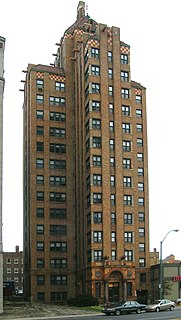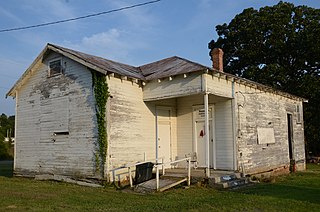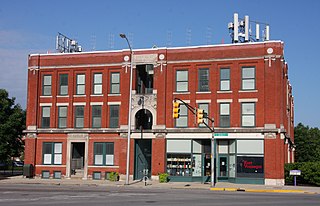
Schenley Park is a large municipal park located in Pittsburgh, Pennsylvania, between the neighborhoods of Oakland, Greenfield, and Squirrel Hill. It is also listed on the National Register of Historic Places as a historic district. In 2011, the park was named one of "America's Coolest City Parks" by Travel + Leisure.

Eccles Avenue Historic District, also known as the David Eccles Subdivision is a historic neighborhood located between 25th and 26th streets and Jackson and Van Buren Avenues in Ogden, Utah, United States. It was listed on the National Register of Historic Places in 1976.

The Bigelow Hotel was a historic hotel located at 2510 Washington Blvd. in Ogden, Utah, United States. Opened in 1927, it was known from 1933-2017 as the Ben Lomond Hotel. It was added to the National Register of Historic Places in 1990. It is notable for its Italian Renaissance Revival architectural significance and as the setting of historical events. The hotel was a member of Choice Hotels' Ascend Collection. In 2019 it was converted to The Bigelow Apartments.

The Drake Court Apartments and the Dartmore Apartments Historic District, built between 1916 and 1921, is located at Jones Street from 20th to 23rd Streets in Midtown Omaha, in the U.S. state of Nebraska. Built in combined Georgian Revival, Colonial Revival and Prairie School styles, the complex was designated a City of Omaha Landmark in 1978; it was listed on the National Register of Historic Places as a historic district in 1980. The historic district originally included 6.5 acres (2.6 ha) with 19 buildings. In 2014, boundary of the historic district was expanded by 0.74 acres (0.30 ha) include three additional buildings, and decreased by 3 acres (1.2 ha) to remove open space and parking that had been re-purposed, for a new total of 4.24 acres (1.72 ha). The district was also renamed to Drake Court Historic District.

The Schenley Farms Historic District, also referred to as the Schenley Farms–Oakland Civic District, is a historic district listed on the National Register of Historic Places that is located in the Oakland section of Pittsburgh, Pennsylvania, United States.

The Bigelow School is an historic school at 350 West 4th Street in South Boston, Massachusetts. The three-story Classical Revival brick building was designed by Charles J. Bateman and built in 1901. Features include corner quoining, cast concrete window lintels and sills. It was named for John P. Bigelow, mayor of Boston when the first school was built on the site in 1850. It was closed by 1976.

The Manchester Apartments is an apartment building located at 2016 East Jefferson Avenue in Detroit, Michigan. It was listed on the National Register of Historic Places in 1985.

The Pasadena Apartments is an apartment building located at 2170 East Jefferson Avenue in Detroit, Michigan. It was listed on the National Register of Historic Places in 1985.

Garden Court Condominiums is a condominium building located at 2900 East Jefferson Avenue in Detroit, Michigan. It was listed on the National Register of Historic Places in 1985.

The Palmer Park Boulevard Apartments District is a collection of three apartment buildings located in Highland Park, Michigan. The district was listed on the National Register of Historic Places in 1992.

The Ponchartrain Apartments was an apartment building located at 1350 East Jefferson Avenue in Detroit, Michigan. It was also known as the Renaissance Apartments. It was listed on the National Register of Historic Places in 1985, but subsequently demolished.

The Kean is an apartment building located at 8925 East Jefferson Avenue in Detroit, Michigan, directly adjacent to the Hibbard Apartment Building. It was listed on the National Register of Historic Places in 1985.

The Bigelow Rosenwald School, also known as Rosenwald Community Center, is a former Rosenwald School located in Toad Suck, about 10 miles (16 km) northeast of Bigelow, Perry County, Arkansas. Built in 1926, it is a single-story wood-frame building with vernacular Craftsman elements. It served as a school until 1964, when it became a community center. It is the only Rosenwald School building that still stands in Perry County.

The D'Iberville Apartments is a complex of historic apartment buildings located in Mobile, Alabama. They were built in 1943 to the designs of architects Harry Pembleton and Aurelius Augustus Evans. They were constructed in a Minimal Traditionalist style of architecture and are notable for their significance to the community planning and development of Mobile during World War II, a time of tremendous growth in the city. The apartments were added to the National Register of Historic Places on September 3, 2004.

The Wilson is a historic Renaissance Revival apartment building located at 643 Fort Wayne Avenue in Indianapolis, Indiana, United States. It was built in 1905 amid an apartment-building boom; more than fifty such apartment buildings were completed in what is now central Indianapolis in 1905 alone.

The Cathcart is a historic apartment building located at 103 E. 9th St. in Indianapolis, Indiana, United States. It was built in 1909 amid an apartment-building boom in what is now central Indianapolis.

The Emelie was built in 1902 by German immigrant Frederick Schmid and named for his wife. The building was saved and restored by Browning Day Mullins Dierdorf Architects to serve as the company's corporate headquarters from 1987 to 2003. It is three stories, constructed of red brick and gray limestone. The building also includes a garden level. It is built in the German Renaissance Revival Architecture style. It has fine decorative detailing, totaling 35,000 square feet (3,300 m2). It has also served as an apartment building and commercial space.

The Harriett was a historic apartment building located at Indianapolis, Indiana. It was built about 1905, and was a three-story, "U"-shaped, Classical Revival style yellow brick and grey limestone building. It has been demolished.

Linwood Colonial Apartments, also known as Colonial Park Apartments, is a historic garden apartment complex and national historic district located at Indianapolis, Indiana. It was built in 1937–1938, and consists of three three-story, Colonial Revival style red brick buildings. It has 106 apartments and includes a "U"-shaped building and two stepped plan buildings.

Shortridge–Meridian Street Apartments Historic District is a national historic district located at Indianapolis, Indiana. The district encompasses 136 contributing buildings in a predominantly residential section of Indianapolis. It was developed between about 1900 and 1951, and includes representative examples of Colonial Revival, Classical Revival, Late Gothic Revival, Mission Revival, Renaissance Revival, Bungalow / American Craftsman, and Art Deco style architecture. Located in the district is the separately listed Shortridge High School. Other notable buildings include the Vernon Court Apartments (1928), Fronenac Apartments (1951), Biltmore Apartments (1927), Meridian Apartments (1929), New Yorker Apartments (1917), Howland Manor (1929), Powell-Evans House (1911), Harms House (1906), Dorchester Apartments (1921), and Martin Manor Apartments (1916).






















